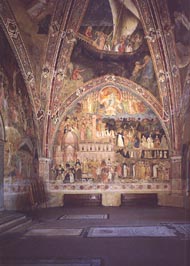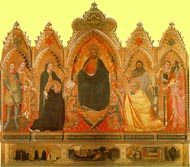
Millard Meiss published in 1951 an influential study entitled Painting in Florence and Siena after the Black Death.. In this study he presented the thesis that art in Tuscany changed dramatically as a reaction to the horror of the outbreak of the plague in 1348. The plague was particularly virulent during the summer of 1348. In Tuscany, for example, a conservative estimate places the death rate in the cities at 60 percent of the population. It is said that on the Feast Day of John the Baptist alone 1,800 people died in Florence, and the same number the next day.
Meiss presents the so-called Strozzi Altarpiece (1354-57)by Andrea Orcagna (Andrea de Cione) (active 1343/44-68) as prime example of the dramatic shift in style:

This work is dramatically different from the early fourteenth century works like Giotto's Ognissanti Madonna:
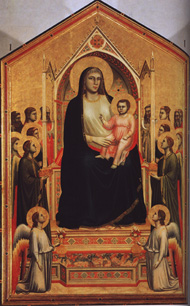
As noted by Meiss, the Orcagna painting shows striking affinities to much earlier works. For example, the Orcagna can be compared to Byzantine Pantocrator images:
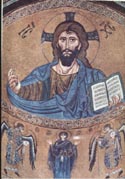
Orcagna's Strozzi Altarpiece was designed for the altar in the Strozzi Chapel in the Church of Sta. Maria Novella:
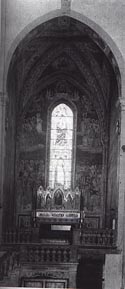
The walls of the chapel were painted by Andrea's brother: Nardo di Cione. Behind the altarpiece is an image of the Last Judgement with the lancet window showing the Madonna and Child with an image of St. Thomas Aquinas below. The wall to the left depicts paradise:
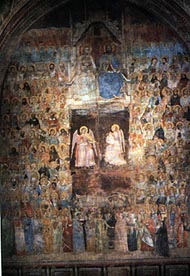
While on the opposite wall appears an image of Hell:
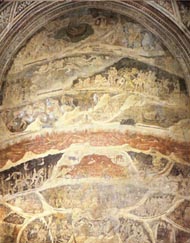
More recently scholars have called Meiss's thesis into question, but there is no question that during the middle of the fourteenth the Florentine social, economic, and political system was under great stress. In the 1340's there was a banking crisis with the bankruptcy of two of the major. During this same decorate there were serious crop failures that led to famine. There was also political instability in Florence. The political and social order was thus in serious instability. Boccaccio's (1313-75) description of the Black Death in his Decameron emphasizes the social chaos:
...people behiave as though their days were numbered, and treated their belongings and their own persons with equal abandon. Hence most houses had become common property, and any passing stranger could make himself at home as naturally as though he were the rightful owner. But for all their riotous manner of living, these people always took good care to avoid any contact with the sick. All respect for the laws of God and man had virtually broken down and been extinguised in our city. For like everybody else, those ministers and executors of the laws who were not either dead or ill were left with so few subordinates that they were unable to discharge any of their duties.
I think these concerns for order underly the changes in style evident in the Strozzi Chapel.
Another major monument of the Florentine art of the second half of the fourteenth century is the Guidalotti Chapel, or Spanish Chapel, in the church of Sta. Maria Novella. This room that was used both as the burial chapel of members of the Guidalotti family and as the chapter house for the Dominican community at Sta. Maria Novella is decorated with frescos by Andrea de Firenze (act. 1346-79) painted between1348-55. The most famous painting in this room is entitled either The Triumph of the Church or The Way of Salvation:
